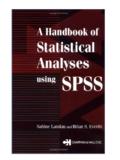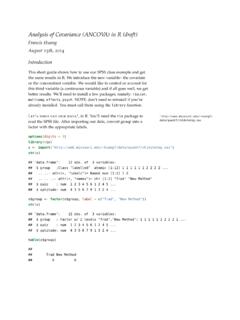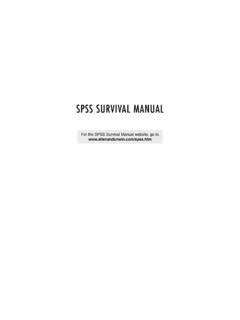Transcription of INTRODUCTION TO SPSS - University of Manchester
1 spss Version 15/03/2017 INTRODUCTION TO spss PART I .. 2 INTRODUCTION .. 2 Background .. 2 Data Entry .. 4 Defining Variables .. 4 Variable and Value Labels .. 7 Entering Data .. 9 FILE MANAGEMENT .. 11 Saving an spss for Windows 7 File .. 11 Backing Up Your Data .. 12 Retrieving Data Files .. 12 DESCRIPTIVE STATISTICS .. 13 Frequency Tables .. 13 Descriptives .. 15 Cross-tabulation .. 16 Three-way tables .. 18 EDITING AND MODIFYING THE DATA .. 19 Inserting Data .. 19 Deleting A Case .. 19 Inserting A Variable .. 20 Deleting A Variable .. 20 Moving A Variable .. 20 PART II .. 21 CONSTRUCTING NEW VARIABLES .. 21 Computing a New Variable .. 21 Computing a New Variable by using built-in Functions .. 22 Computing Duration of Time Difference by built-in Functions .. 23 Recoding a value .. 24 Selecting a Subset of the Data .. 26 GRAPHICS .. 28 Bar Charts .. 28 Histograms .. 29 Scatter Plots.
2 30 Plotting a Regression Line on a Scatter Plot .. 31 STATISTICAL INFERENCE IN spss .. 32 INTRODUCTION .. 32 Categorical Variable .. 32 The Chi-squared test and Fisher s Exact test .. 33 CONTINUOUS OUTCOME MEASURES .. 35 Comparison of Means Using a t-test .. 37 LINEAR REGRESSIONS .. 40 Model Checking .. 41 NON-PARAMETRIC METHODS .. 43 COMPARISONS OF RELATED OR PAIRED VARIABLES .. 45 Continuous Outcome Measures .. 46 Analysis of Binary Outcomes that are Related .. 47 Related Ordinal Data .. 48 LOGISTIC REGRESSIONS .. 48 Model Checking .. 50 SURVIVAL ANALYSIS .. 51 READING AN EXCEL FILE INTO spss .. 54 CREATING A spss SYNTAX .. 56 spss Version 15/03/2017 2 PART I INTRODUCTION Background This handbook is designed to introduce spss for Windows. It assumes familiarity with Microsoft windows and standard windows-based office productivity software such as word processing and spreadsheets.
3 spss for Windows is a popular and comprehensive data analysis package containing a multitude of features designed to facilitate the execution of a wide range of statistical analyses. It was developed for the analysis of data in the social sciences - spss means Statistical Package for Social Science. It is well suited to analysing data from surveys and database. The practical uses dataset from a cross-sectional survey of respiratory function and dust levels amongst foundry workers. The object of the survey data was to determine whether the dust levels found in the foundries have any effect on the respiratory function. Acquiring the DATA A number of datasets have been created to enable you to work through this guide. These can be found online or via the Shared Data folder. To access click the Start button in the bottom left hand corner and type - shared data and press enter, the window explorer will open and then double click: mhs > health methodology course data > We suggest you copy and paste , , and to your desktop.
4 To access the data online click the link: and download the relevant spss handouts and above datasets to your desktop. You may at some point be asked for your username and password. Note: for further information this booklet where possible will link you to a relevant Youtube video explaining the technique discussed. spss Version 15/03/2017 3 Starting spss After logging on to Windows 7, the user will be presented with a screen containing a number of different icons. Start spss by clicking the Start button then selecting All Programs IBM spss Statistics IBM spss Statistics Then the spss for Windows 7 screen will appear called Untitled spss Data Editor (shown below). In the middle of the Data Editor screen you can see another window with the following options - New Files Create a new dataset Recent Files Open a previously used dataset What s New Learn about new features in spss Modules and Programmability Links to help menus for advanced users Tutorials Beginners guides to features in spss Click, the New Dataset within the New Files option, to get a blank spss data screen and the maximise your spss window.
5 spss Version 15/03/2017 4 Data Entry The spss Data Editor screen looks like a spreadsheet but there are some important differences. Each row represents the data for a case. A case could be a patient or a laboratory specimen. It could also be a set of results for a patient at a particular time. Each column represents a variable. A variable could be the answer to a question or any other piece of information recorded on each case. Before you enter any data in the spreadsheet you have to create a variable for the information you have collected. You must define a variable for each question in your data set you plan to analyse. Defining Variables If you look at the left hand corner at the bottom of the spss Data Editor screen, you will see two small tabs labelled: Data View and Variable View. To create a new variable click on Variable View and the following screen will appear.
6 Each row describes the attributes of one variable. Begin by entering a variable name in the Name column. A variable name can be up to 64 characters long, must contain no spaces, and should be something meaningful. It is best to stick to alphanumeric characters and start with a letter. Once you have entered a name, spss defines the variable type as Numeric. You may need to change the variable type, to String if you wanted to use text such as names, or to Date if you want to enter dates. To do this, click on the cell within the Type column. A little combo button will appear on the right hand side, click the button and the following screen will appear. spss Version 15/03/2017 5 You will usually be working with one of Numeric, Date or String type of data. For Numeric variables you may want to change the decimal places.
7 If the data are integers (whole numbers) such as age in complete years you could alter the decimal places to zero. If the numbers you are planning to enter are very small ( ) or you require a high level of precision ( ) you may want to increase the number of decimal places. Usually there is no need to change the width from 8, note that width must be larger than the number of decimal places. For a date variable it is best to use a 4 digit year ( ) With text strings you are given the option to change the number of characters spss Version 15/03/2017 6 Where possible you are strongly advised to use numerical coding rather than strings as this makes statistical analysis easier. If you are entering string data that is longer than 8 characters, you will need to increase the Width from the default of eight. To be able to fully display the string in the data view window you may need to increase the numbers of columns in the variable view window.
8 The column missing in the variable view window allows you to define codes that identify a missing value. You can have several values allowing you to distinguish between types of missing data due to the respondent forgetting to answer rather than say not applicable or refused to answer. For example, a code of -88 could indicate not applicable, and -99 could indicate the respondent had missed a question out. If a value is defined as a missing value code for a particular variable, subjects with that code will be dropped from the analysis of that variable. To set up missing value codes for a variable, click on a cell followed by the grey square within the Missing column as you did with Type. Click Discrete missing values and enter the values to represent missing in the boxes below (Up to 3 can be entered). To complete the entry press OK spss Version 15/03/2017 7 Variable and Value Labels There are two types of labels in spss .
9 A variable label, given to a variable gives a clearer description of the variable and will be displayed on the statistical output such as graphs and tables. The second, a value label allows you to describe each of the values in a variable. These labels will be displayed on tables improving readability. For example, Exposure group in the following practical has two values Unexposed and Exposure to dust which are coded as 0 and 1 . The label option in the variable view window also allows you to define labels for missing values. To define a variable label click the cell within a Label column screen and enter your description of the variable. To define Value Labels - click the cell of the value column and then the click on the combo button to the right, then enter the Value and its associated label then press Add. The added label will then appear in the window below.
10 Once you have entered all the value labels for a variable press OK. spss Version 15/03/2017 8 Exercise The table below lists the example variables from the foundry study. Set-up the following variables Variable Name Description (Variable Label ) Missing Data Code Value Labels for each code idno Identification No group Exposure Group 1 = Exposed to dust 0 = Unexposed age Age at assessment sex 0 = female 1 = male ht Height in cms asthma Ever had asthma 0 = No 1 = Yes 2 = Don t Know bron Ever had Bronchitis 0 = No 1 = Yes 2 = Don t Know smknow Do you smoke now 1 = Yes 0 = No smkever Have you ever smoked 0 = No 1 = Ex smoker 2 = Current smoker cigno No of cigarettes per day -88 cigyrs No of years smoked -88 spss Version 15/03/2017 9 Entering Data When you finish creating all the variables, you enter the Data View and the following screen with all the variable names at the top of the spreadsheet.







